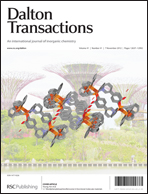A novel structural rearrangement reaction of dialkylated derivatives of [Pt2(μ-S)2(PPh3)4] involving Pt–C bond formation†
Abstract
Reaction of [Pt2(μ-S)2(PPh3)4] with the dialkylating agents ClCH2C(O)CH2Cl or ClCH2C(![[double bond, length as m-dash]](https://www.rsc.org/images/entities/char_e001.gif) NNHC(O)NH2)CH2Cl gives the dicationic di-μ-thiolate complexes [Pt2{μ-SCH2C(O)CH2S)(PPh3)4]2+ or [Pt2{μ-SCH2C(
NNHC(O)NH2)CH2Cl gives the dicationic di-μ-thiolate complexes [Pt2{μ-SCH2C(O)CH2S)(PPh3)4]2+ or [Pt2{μ-SCH2C(![[double bond, length as m-dash]](https://www.rsc.org/images/entities/char_e001.gif) NNHC(O)NH2)CH2S}(PPh3)4]2+, isolated as BPh4− salts and characterised by ESI
NNHC(O)NH2)CH2S}(PPh3)4]2+, isolated as BPh4− salts and characterised by ESI ![[double bond, length as m-dash]](https://www.rsc.org/images/entities/char_e001.gif) NNHAr)CHS}(PPh3)3Cl] [Ar = C6H3(NO2)2] in which a PPh3
NNHAr)CHS}(PPh3)3Cl] [Ar = C6H3(NO2)2] in which a PPh3
![Graphical abstract: A novel structural rearrangement reaction of dialkylated derivatives of [Pt2(μ-S)2(PPh3)4] involving Pt–C bond formation](/en/Image/Get?imageInfo.ImageType=GA&imageInfo.ImageIdentifier.ManuscriptID=C2DT31637D&imageInfo.ImageIdentifier.Year=2012)

 Please wait while we load your content...
Please wait while we load your content...